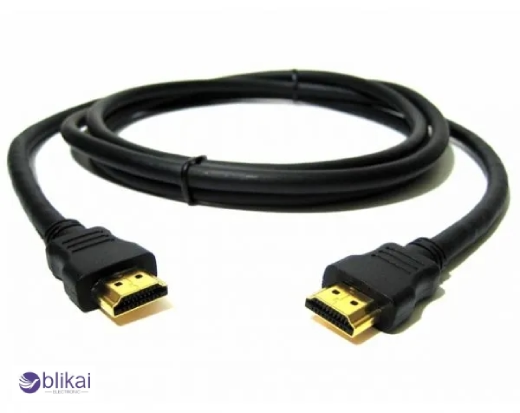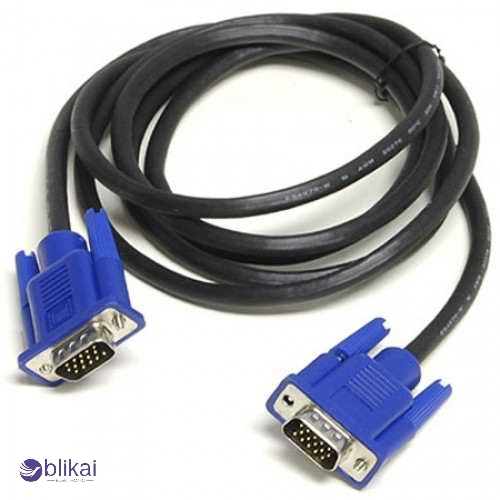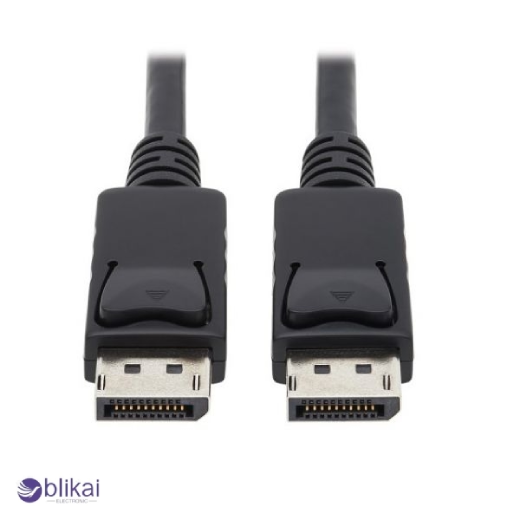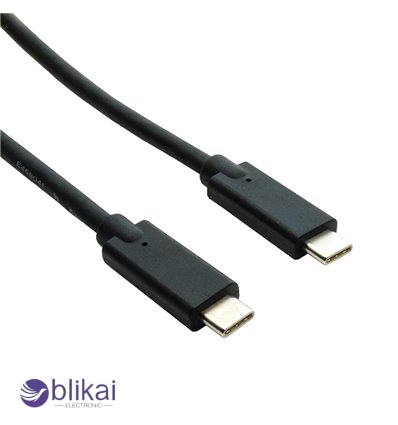Monitor Cable Types: A Complete Guide (2025)
Modern society is quite accustomed to seeing cables. Besides charging your phone, tablet, and laptop, you can also connect multiple devices to it. The technical definition of a cable is a thick wire or a bunch of wires surrounded by an insulator. A cable transports electricity or carries electronic signals. Plugs, cords (which is quite popular) and connectors are other names for them. Cables that connect CPU components are called monitor cables. For setting up a PC or connecting different devices to your laptop. The following is a detailed guide on how to use and different monitor cable types and advantages.
Different Monitor Cable Types
You need the right monitor cable to get the best display and performance. Understanding the differences in cables is crucial since they support different resolutions, refresh rates, and features. It's important to pick the right cable for your needs, whether you're gaming, working, or just laying around. There are a few types of monitor cables:
HDMI (High-Definition Multimedia Interface)

Everything changed when HDMI cables were introduced. Can audio and video be transmitted over the same wire? An absolute game changer. Before HDMI, connecting a TV or computer required multiple cables. It's messy. A few years later, HDMI was introduced. As a result, it became the standard for TVs, gaming consoles, laptops, and many other electronic devices. Tangled cords are a thing of the past. It's as simple as plugging in.
We are now in the present day. It is everywhere that HDMI is used. All the good stuff is supported, such as 4K, 8K, high refresh rates, HDR, and deep colors. A PS5 or Xbox can be used to play fast-paced shooters or binge watch Netflix. HDMI is a great source of entertainment. Despite the differences in versions, the core concept remains the same. There is only one cable.
Features
High-Quality Video & Refresh Rates
HDMI supports resolutions ranging from 720p to 8K. Would you like to play at 120Hz or 144Hz with smooth gaming? There's no escaping it. Have you ever watched a movie in 4K HDR? Nothing to worry about. You can throw anything at it and it will adapt.
Audio and Video in One Cable
It is not necessary to use extra audio cables. HDMI transmits both audio and video simultaneously. It can be used with soundbars, home theater systems, and surround sound systems. Connect it and you're good to go.
Multiple Versions for Different Needs
There are different types of HDMI cables. Using HDMI 1.4 at 30Hz, you are able to view basic 4K at 30 frames per second. There is a step up to 4K at 60Hz with HDMI 2.0. Then there's HDMI 2.1, which is the beast. A next-level gaming experience for 8K, 120Hz, VRR, and ALLM is possible.
Universal Compatibility
There are almost no restrictions on its use. Streaming devices, gaming consoles, TVs, monitors - everything is available. It's a standard. You don't have to do anything except plug it in.
Easy to Use, But Limited Length
HDMI is reliable and does not have any complications. There is a problem with it over long distances, however. An active cable or booster will be needed if the signal drops further than 50 feet. Keeping that in mind is important.
VGA Cable (Video Graphics Array)

VGA was the predecessor to HDMI and DisplayPort. Monitors, projectors, and early flat-screen TVs were connected to computers through this cable. In 1987, IBM introduced this video output device, which became the go-to for video outputs. Office PCs and gaming setups have both used it for years. The technology is still being used in some older systems and budget monitors today.
Nevertheless, technology advances rapidly. A VGA display is analog as opposed to a HDMI or DisplayPort display. In other words, the resolution is lower, the colors are weaker, and there is signal interference over long distances. However, it struggles to handle resolutions above 1080p. DisplayPort and HDMI are the two most popular interfaces for modern displays. In legacy systems, VGA still serves as a backup option.
Features
Analog Video Transmission
HDMI transmits digital signals, whereas VGA doesn't. The video quality is dependent on the cable and the device since it is an analog technology. Long distance signals degrade, leading to screen blurriness or ghosting.
Lower Resolution Support
The VGA format was great when it first came out, but it's now outdated. 1920x1080 (1080p) is the maximum resolution it supports, but anything higher gets distorted or blurry. HDMI and DisplayPort are required to improve the clarity and sharpness of modern displays.
No Audio Support
Video signals are the only signals carried by VGA. Connecting speakers or headphones requires a separate audio cable, as opposed to HDMI. Game or multimedia setup becomes more complicated as a result.
Universal Compatibility
Though VGA is an old technology, there are still a lot of devices that use it. Most monitors, projectors, and laptops have VGA ports. Even though it's affordable and reliable, some schools and businesses still use it.
Requires a VGA Adapter for Modern Devices
In most laptops and GPUs today, VGA ports are not available. VGA adapters are required to connect modern devices to VGA. Digital signals are converted to analog signals by these converters, but the image quality is still inferior to that of newer cables.
DisplayPort Cable

Despite HDMI's stronghold on high-performance displays, DisplayPort's power is what sets it apart. In 2006, VESA (Video Electronics Standards Association) introduced it as the popular choice for PC gamers and professionals. VGA and HDMI are designed for analog signals, while DisplayPort is built for raw speed, high resolutions, and multiple display setups.
Initially, HDMI looks the same as it, but their purposes are vastly different. HDMI is everywhere—TVs, gaming consoles, home theaters. However, DisplayPort is the dominant port in the PC world. For high-refresh-rate monitors, multi monitor workstations, and 8K clarity, this cable is for you. Many gaming GPUs, professional graphics cards, and high-end monitors use it despite its less common use than HDMI.
Features
Superior Resolution and Refresh Rates
On high-end displays, DisplayPort outshines HDMI. Each version pushes the limits. Four-channel 4K at 240Hz, eight-channel 8K at 60Hz, and ten-channel 10K at 60Hz. That means crisp visuals, buttery smooth animations. No lag. No screen tearing. It’s a game-changer for pro gamers, designers, and video editors.
Multi-Monitor Daisy-Chaining
Need multiple screens? DisplayPort makes it easy. A single DisplayPort output can be split across several HD monitors or two 4K displays using Multi-Stream Transport (MST). Perfect for stock traders, content creators, and anyone serious about productivity. Less cable clutter. More efficiency.
Adaptive Sync for Gaming
Smooth, and Seamless. That’s what Adaptive Sync brings to gaming. It syncs refresh rates, reducing stuttering, tearing, and input lag. Unlike HDMI, DisplayPort works natively with FreeSync and G-Sync. If you’ve got a high-refresh-rate monitor, this is what you want. Every frame stays sharp, no ghosting.
DisplayPort Versions for Every Need
There’s a DisplayPort for everyone. Older DP 1.2 supports 4K at 60Hz. DP 1.4 bumps that up to 8K at 60Hz with HDR. The latest DP 2.0 takes it further, supporting 10K at higher refresh rates. Whether for casual browsing or cutting-edge gaming, there’s a version that fits.
Universal with the Right Adapter
Got an older TV or gaming console? No problem. With the right adapter, DisplayPort converts seamlessly. It works with HDMI, DVI, even VGA. No need to toss out old hardware. Just adapt it, plug it in, and enjoy top-tier performance on any screen.
Thunderbolt Cable

Easy to use, versatile, and expensive. Here's a quick summary of Thunderbolt. At the time of its launch in 2011, people weren't sure whether it would be a success. Although it looked like a Mini DisplayPort cable, it was something entirely different on the inside. Audio and video weren't the only things Thunderbolt could do. Basically, it was a cable that carried power, data, and ultra-fast speeds. As time passed, it evolved. In today's world, Thunderbolt 4 has become one of the most powerful connections.
Thunderbolt can be used for more than screens, unlike HDMI and DisplayPort. A GPU, SSD, docking station, and even an entire monitor array can be connected to the interface. Whether you are a creative professional, a power user, or a Mac enthusiast, this is the software you need. The technology is also supported on Windows PCs, but Apple has always embraced it. What are the biggest drawbacks? The device is expensive, and it isn't supported by every device.
Features
Blazing Fast Data Transfer
In addition to displays, Thunderbolt can be used for other things as well. One of the fastest connections available, it can transfer data up to 40Gbps. With it, huge 4K videos can be moved, external SSDs can be accessed, or complex workflows can be run without lag.
Supports High-Resolution Displays
With Thunderbolt, you can connect four-k, five-k, or even eight-k monitors simultaneously. In addition to displaying 4K content at 60Hz, it can also display 8K content, making it the ideal device for professionals.
Single-Cable Docking
Thunderbolt allows you to connect everything with just one cable. In addition to transmitting video and data, it also provides power. The docking station allows users to connect multiple peripherals-monitors, external drives, and accessories-without having to deal with cables.
Daisy-Chaining for Multiple Devices
With Thunderbolt, you can daisy-chain up to six devices using just one port. Multi-monitor setups, video editing stations, and high-speed storage solutions can benefit from this.
Backward Compatibility with USB-C
Several Thunderbolt cables do not support USB-C connectors, including Thunderbolt 3 and 4. Isn't that good news? Thunderbolt ports are compatible with USB-C devices, which makes it a very flexible standard. It is only with a certified Thunderbolt cable that you can experience Thunderbolt's full speed.
USB-C Cable

Easily portable, powerful, and everywhere. That's what USB-C is all about. In the beginning, people were confused by it. There was a difference between the USB-A and USB-B cables. Connectors no longer have to be bulky and clunky. The cable does not need to be flipped three times to be plugged in. In addition to being reversible, fast, and universal, USB-C was also reversible. It was adopted by smartphones, laptops, tablets, and even gaming consoles within just a few years.
In addition to charging phones, USB-C is capable of doing much more. A data transfer device, video output device, or even a power delivery device can be attached to it. Depending on what type of cable you choose, you may be able to charge smartphones, tablets, or external hard drives. There are, however, differences between USB-C cables. Data transfer is slow in some, improper shielding is present in others, and some can't even send data. Choosing the right one? That's where it gets tricky.
Features
Reversible and Easy to Use
It's no longer necessary to struggle with USB ports. Plugging USB-C in doesn't require flipping it repeatedly, since it's reversible. You won't be frustrated anymore, just a quick and easy connection.
Fast Data Transfer
It depends on the version of USB-C whether it supports different speeds. It is possible to transfer data at 10 Gbps with USB3.1, while 40Gbps is possible with USB4. The result is faster transfers of large files, HD movies, or entire backups.
Power Delivery for Fast Charging
Data isn't the only thing USB-C can do. Devices can be charged more quickly and efficiently thanks to Power Delivery (PD). A laptop, a tablet, and even a gaming console like the Nintendo Switch can be charged with it at up to 100 Watts.
Supports Video Output
HDMI and DisplayPort can be replaced with USB-C cables for transmitting video signals. Therefore, many modern laptops use USB-C for direct connection to monitors. DisplayPort Alt Mode is required to support 4K and 8K displays.
Universal and Future-Proof
A global standard is emerging for USB-C. Besides MacBooks, Windows laptops, Android phones, iPads, external hard drives, and even car chargers, it's compatible with all these devices. With more devices using it, carrying fewer cables and being more compatible is easier.
Final Thoughts
You shouldn't have any trouble finding the right monitor cable since there are so many on the market. HDMI, VGA, and USB cables? Today, they're everywhere, much more common than they used to be. But here's the thing: not all cables are the same. When you install the wrong one, your display quality can be affected, flickering may occur, or it may not even work.
How should they be handled? It matters as well. Are the pins bent? The thought of that is terrifying. A little care goes a long way. Make sure they are organized, don't pull them out, and don't bend them at sharp angles. Need the best performance? Choose brands that you can trust on BLIKAI. The cheaper, no-name cables might seem like a good deal at first, but what happens when they break at the most inopportune moment? Your wallet will thank you for getting the good stuff.
Related Articles
Varieties of Electrical Wires and Cables
The Automotive PCB Market Seizes Fresh Opportunities
2N3904 vs 2N2222:What You Need to know
How Does a Single Phase Motor Work?
Difference Between Isolator and Circulator? [Guide]
What do Microminiature and Ultraminiature RF connectors entail?
Difference Between Serial and Parallel Communication
STM32F407IGT6 Microcontroller: Features, Applications and Datasheet
FPGA vs ASIC: Which one should you Choose?
What is a RF Modulator? Everything You Need to Know










